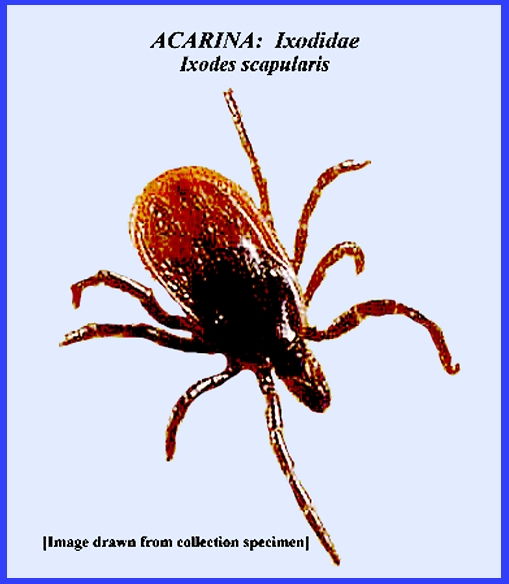File: <tickparalysis.htm> <Medical
Index> <General Index> Site Description Glossary <Navigate
to Home>
|
TICK PARALYSIS (Contact) Please
CLICK on Image & underlined links for details: The symptoms resemble poliomyelitis and show up after 4
to 7 days following the bite of a tick, with young children being especially
vulnerable. This is followed by an gradual paralysis in the legs disabling
walking or standing. Afterwards the
arms are paralyzed and other functions such as talking, swallowing and
breathing are curtailed. These
symptoms are painless but there may be a fever. Mortality is rare in humans but more apt to occur in animals
from respiratory failure. The
severity of symptoms varies with different species and/or populations of
ticks (Service 2008). Primarily responsible in North America are Dermacentor
andersoni and D. variabilis. Removing the ticks usually gives complete recovery after
two days, but severe cases require longer. = = = = = = = = = = = = = = = = = =
= = Key References: <medvet.ref.htm> <Hexapoda> Bequaert, J. 1931.
Synopsis des tiques du Congo belge.
Rev. Zool. Bot. Afr. 20:
209-251. Bequaert, J. 1946. The ticks or Ixodoidea of the northeastern United States and
eastern Canada. Entomologica Americana 25:
73-232. Bishopp, F. C. 1935. Ticks
and the role they play in the transmission of diseases. Rept. Smithsonian Inst. for 1933, pp.
389-406. Bishopp, F. C. & H.
P. Wood. 1913. The biology of some North American ticks
of the genus Dermacentor. Parasitology 6:
153-187. Camicas, J. L., J. . Hervy, F. Adam & P.
C. Morel. 1998. The ticks of the world (Acarida,
Ixodida): Nomenclature, Described Stages,
Hosts,Distribution. Paris: Editions de l'ORSTOM. Dumler, J. S. & D.
H. Walker. 2005. Rocky mountain spotted fever: changing
ecology and persisting virulence. New
England J. of Medicine 353: 551-53. Ferguson, E. W. 1924.
Deaths from tick paralysis in human beings. Med. J. Australia 2(14):
346-348. Fielding, J. W. 1926.
Astralasian ticks. Ser. Publ. (trop. Div.) Australia
Dept. Hlth., No. 9. Gammons, M. & G.
Salam. 2002. Tick removal. Amer. Fam. Physician 66:
643-45. Gothe, R., K. Kunze
& H. Hoogstraal. 1979. The mechanisms of pathogenicity in the
tick paralyses. J. Med. Ent. 16: 357-69. Hadwen, S.
1913. On "tick
paralysis" in sheep and man following bites of Dermacentor venustus,
with notes of the biology of the tick.
Parasitology 6:
283-297. Hoogstraal, H. 1966. Ticks
in relation to human diseases caused by viruses. Ann. Rev. Ent. 11:
261-308. Hoogstraal, H. 1967.
Ticks in relation to human diseases caused by Rickettsia species. Ann. Rev. Ent. 12: 377-420. Lewis, E. A. 1934.
A study of the ticks of Kenya Colony.
Bull. Dept. Agr. Kenya, No. 7. Lewis, E. A. 1939. The
ticks of East Africa. Emp. J. Expt.
Agr. 7(27: 261-270; 7(28): 299-394. Mail, G. A. & J. D.
Gregson. 1938. Tick paralysis in British Columbia. J. Canad. Med. Assoc. 39: 532-537. Matheson, R. 1950. Medical Entomology. Comstock Publ. Co, Inc. 610 p. McCormack, P. D. 1921.
Paralysis in children due to the bites of wood ticks. J. Amer. Med. Assoc. 77: 260-263. Needham, G. R. & P.
D. Teel. 1991. Off-host physiological ecology of ixodid
ticks. Ann. Rev. Ent. 36: 313-52. Parola, P. & D. Raoult. 2001.
Tick-borne typhuses. IN: The Encyclopedia of arthropod-transmitted
Infections of Man and Domesticated Animals. (ed.) M. W.
Service, Wallingford: CABI: pp.
516-24. Service, M. 2008.
Medical Entomology For Students.
Cambridge Univ. Press. 289 p. Sonenshine, D. E., R. S. Lane & W.
L. Nicholson. 2002. Ticks
(Ixodida). IN: Medical & Veterinary Entomology, ed. G. Mullen & L.
Durden, Ambsterdam Acad. Sonenshine, D. E. &
T. N. Mather (eds.) 1994. Ecological Dynamics of Tick-Borne
Zoonoses. Oxford Univ. Press, New
York.Press pp
517-58. |
